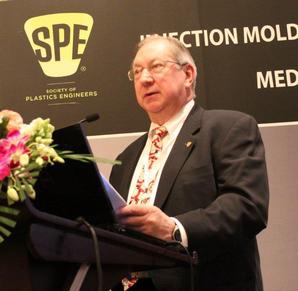Rebecca Kanthor
PLASTICS NEWS CORRESPONDENT
Published: December 26, 2013 8:04 am ET
Updated: December 26, 2013 8:07 am ET

Image By: Rebecca Kanthor
Len Czuba
SHANGHAI — China's growing middle class and aging population will affect the global medical device market in 2014, according to speakers at the Society of Plastic Engineers' first China conference, held Dec. 11-12 in Shanghai.
"In China, the 83 million people defined as middle class only represent less than 10 percent of the population," said Michael Taylor, senior director of international affairs and trade at the Washington-based Society of the Plastics Industry Inc. "The idea is that if your middle class is growing, your economy is getting richer and you can afford these things.
"Domestically, the middle classes will have a growing voice by means of higher purchasing power, moving up the consumption chain to high-end, more technical goods," he said.
China's population also is getting older, Taylor added. China's elderly population will triple from over 100 million to over 300 million by 2050. This aging population will create a greater need for long-term care.
Rising spending on health care in China will have an impact on imports of U.S.-made medical devices, Taylor said. China's desire for U.S. imports is growing faster than demand from other countries.
Mark Bonifacio, owner of Natick, Mass.-based Bonifacio Consulting Services LLC, noted a related trend: China and Asia are emerging as a huge market for global healthcare-related companies.
Bonifacio said we are seeing the beginning of a "made in China, for China" sector of the medical device industry.
"You see that with the big OEMs setting up design centers in Asia, some of the biggest of the big in the U.S., and they're making a very concerted effort to put the design teams where they'll be making and selling the products," he said in an interview with Plastics News on the sidelines of the conference.
He added that "made in China" is becoming more trusted in the medical device sector.
"There are some high quality products that are being manufactured in China now, things that were not being manufactured as little as 5-10 years ago, so the capabilities are quickly ramping up in terms of [what's] being manufactured here," Bonifacio said. For example, tooling capabilities are improving.
"I call China the tooling capital of the world because they're building a lot of the tools, not just for medical but for almost any industry that you can think of," he said. "They're supplying a good part of the world with molds."
As labor costs in China rise, Chinese companies are also beginning to look to automation, he said, not just to cut costs but also to improve quality and reduce risk of repeatedly training and then losing seasonal workers.
But while China as a market is growing and China's manufacturing capabilities are rising, foreign companies are increasingly facing pressures that could lead them away from manufacturing medical devices in China. One is price.
"Outsourcing is going to be almost exclusively geared towards very high labor content products," Bonifacio said. "If you have something that can be automated or has very little labor, the savings have just about evaporated. By the time you factor in excess inventory, time on the water, the extra resources of people traveling out here; if you look at the total cost of ownership, the savings have somewhat evaporated."
Another pressure that companies are facing is engineer fatigue. Bonifacio said some U.S. employees are beginning to rebel; they are no longer are willing to sacrifice nighttime after-work hours for conference calls overseas.
"It sounds kind of silly, but those are the kind of soft things that that take a toll on an organization," he said. This backlash over quality of life issues has led some companies to search for manufacturing in countries or regions that are closer and with a less drastic difference in time zones. The price may be slightly more expensive, he said, but the companies think it is worth it to lessen the hassle of working with partners so far away.
As for medical devices that are entering the market, Len Czuba, principal of Czuba Enterprises, highlighted several advances that he thinks have a future in the market.
The trend is leaning towards more mobile devices, Czuba said. Healthcare is moving away from hospitals and into home environments. and devices are shifting towards ability to be used by non-doctors. In the example of an EKG monitor that works through a mobile phone app.
That trend can help bring affordable care to remote regions.
While the growth of the medical device market in China and made in China is exciting, Bonifacio had a few words of caution.
He said companies need to be patient and work on building trust with their partners — and not just in China.
"All those successes working with Chinese companies, it's been a pretty close relationship built over time or someone who was recommended by another medical company where you already had a good relationship. I can't emphasize that enough," he said. "The people I see who come out here blindly, they all end up with some sort of an issue. That's usually when we get a lot of phone calls." | 